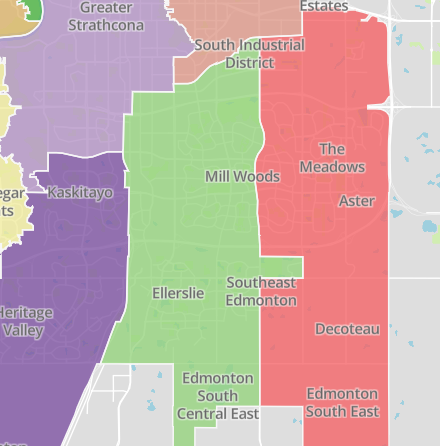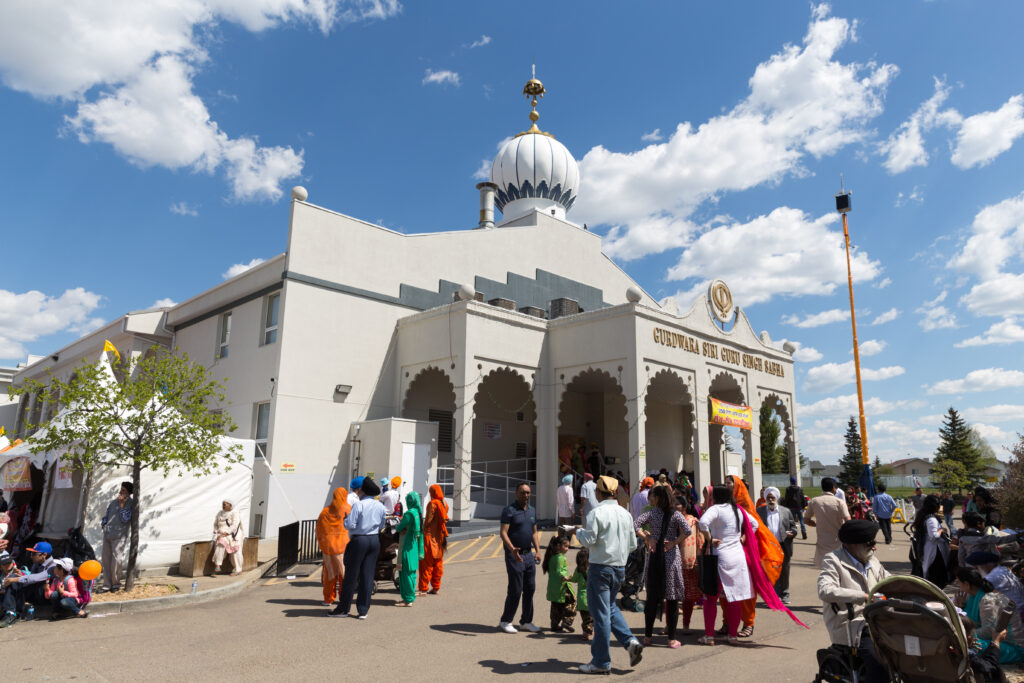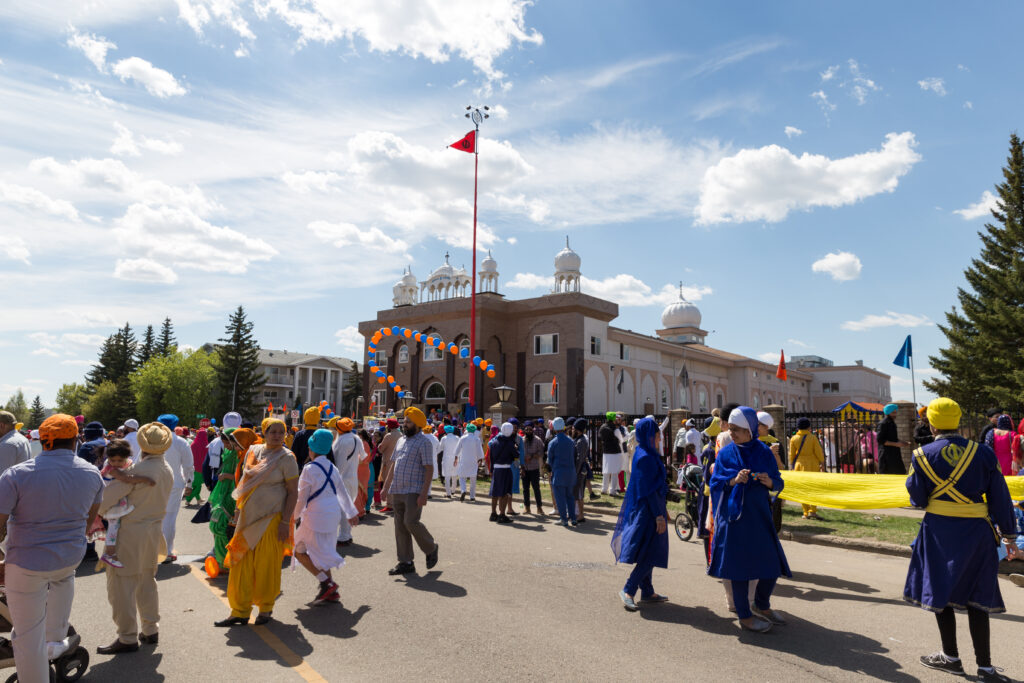If you come to Mill Woods on the Sunday of Victoria Day long weekend, you’ll join thousands of people coming together in colourful celebration. Walking on Mill Woods Road, local families and businesses provide cha, juice, water, samosas, pizza, and an endless list of other good eats to the crowd. This is just a small part of the experience at the annual Vaisakhi Nagar Kirtan, which is hosted by the Vaisakhi Nagar Kirtan Committee (VNKC) of Edmonton on behalf of the Sikh community.
The Sikh faith is one of the youngest world religions, founded in 1469 in Punjab by Guru Nanak.
A Sikh is someone who accepts the Guru Granth Sahib (Eternal Guru and sacred Sikh scriptures) as their teacher/guide in the active pursuit to recognize and connect with IkOnkar. The principal belief of Sikhism is IkOnkar, meaning there is One: One Creator, One Light, One Source; all of creation comes from the same source and the Jot (Light, spirit) of IkOnkar exists within all Creation and outside of all Creation. We are all embodiments and connected through IkOnkar.

The upcoming 22nd Edmonton Vaisakhi Nagar Kirtan will be on Sunday, May 22, 2022, starting at noon from Gurdwara Millwoods and concluding at 5pm Gurdwara Sri Guru Singh Sabha.
There will be a 2 hour stop at Pollard Meadows Park, south of T.D. Baker school.
Wards Karhiio and Sspomitapi in South East Edmonton. From City of Edmonton OpenData
What is the Vaisakhi Nagar Kirtan Committee?
As settlers on this land, members of the Sikh communities came to Canada with their unique identity. In the past 20 years, the Sikh community has grown significantly in population and is now roughly over 50,000 people. Local Edmonton Gurdwaras (places of Sikh worship) collectively participate and represent Sikh interests in Edmonton, Alberta, through the VNKC of Edmonton.
Up until recently, there have been four cornerstone Gurdwaras within Edmonton, with two located in Southeast Edmonton, and two located in North. The first Gurdwara in Edmonton is Nanaksar in the northeast – it was established in 1975, followed by Siri Guru Nanak Sikh Gurdwara in northwest and Gurdwara Millwoods and Gurdwara Siri Guru Singh Sabha in southeast. With the recent growth in population, additional Gurdwaras are being established.
When the first Vaisakhi Nagar Kirtan was held in 1999, the organizing committee was only intending to hold a one-time event to celebrate the 300th anniversary of the creation of the Khalsa Panth. In speaking with three of the current members of the Vaisakhi Nagar Kirtan Committee of Edmonton, two of which were on the founding committee in 1999, they had no idea that the Vaisakhi Nagar Kirtan would grow into an annual cornerstone community event.
The members of the original Committee migrated to Edmonton over the 1960s to 1990s. All were actively volunteering in Executive Committees of one of the local Gurdwaras and were founding Sikh establishments and spaces for themselves and future generations.
Pal Singh Purewal migrated to Edmonton in September 1974 at the age of 42. Mr. Purewal was the first chairman of the VNKC and an engineer by profession. Now 89, Mr. Purewal has significant notable achievements in the Sikh community, including researching and publishing the Nanakshahi calendar. Mr. Purewal has also received recognition from the Government of Pakistan on his contributions to the Islamic community for creating the Hijri Calendar. Gurcharn Singh Sangha migrated to Canada at the age of 24 in 1972 and moved to Alberta in 1975. Mr. Sangha spent his career working with Canada Post and is the longest serving member of the VNKC. Surinder Singh Hoonjan migrated to Edmonton in 1980 at the age of 27. Mr. Hoonjan was an auditor by profession and is the current chairman of the VNKC.
As migrants and racialized people, members of the Committee personally experienced racism and discrimination. All three of them shared that on top of having to adjust to the challenges of moving to a foreign land, they experienced verbal harassment and negative race-based comments because of their physical appearance (such as color of their skin) and unique Sikh identity (including turbans, beards) in both personal and professional environments, resulting in worry, anxiety, and sleepless nights. With similar common experiences, these individuals were committed to having other Edmontonians know who they are, who Sikhs are. The VNKC became the space where they would celebrate the Khalsa Panth and share the Sikh identity and values with the rest of Edmonton.
Through Oneness and connectedness, we are no longer strangers to each other; rather, we see each other through love and acceptance while granting each other the grace to live our individual lives according to belief systems that honour our unique identities.

Photo credit: Mack Male (Flickr: mastermaq)
What is a Nagar Kirtan?
The spirit of the Nagar Kirtan echoes the journey of Guru Nanak, the founder of the Sikh religion.
Guru Nanak traveled an estimated 28,000 kilometers over 24 years to share his message of IkOnkar with the world. Throughout Sikh history, a Nagar Kirtan would occur when the Sikh Guru would travel to share the Sabad (revelations from the Creator) with the general public. Members of the community would go to receive the Guru, traveling back to the village with the Guru.
Following Sikh tradition, the Nagar Kirtan in Edmonton is a procession led by the Punj Pyare (the 5 Beloved Ones) and the Guru Granth Sahib (the Eternal Guru and sacred Sikh scriptures). The Sikh faith was established in 1469 by Guru Nanak. Nine living Gurus followed, until the 10th and last human form of a Sikh Guru, Guru Gobind Singh. Guru Gobind Singh proclaimed the Guru Granth Sahib the Eternal and Infinite Guru of the Sikh Faith in 1708, proclaiming that no future human Guru will exist and any person who identifies as a Sikh shall follow and accept the teachings within the Guru Granth Sahib exclusively. The Guru Granth Sahib includes poetic writings of 6 of the Sikh Gurus, along with poetry of other writers from the time, to be a source of learning, contemplation, reflection, and teachings for the followers of the SIkh faith.
In the Edmonton Nagar Kirtan, the Punj Pyare walk ahead of the first float which carries the Guru Granth Sahib. A Granthi (person who studies, reads, and interprets the scriptures) sits and attends the Guru Granth Sahib. Often, the verses of the scripture are sung by Ragis for all to hear and reflect upon. Prior to the adoption of commercial vehicles, Nagar Kirtans were completed by walking and the Guru Granth Sahib was held upon the head of a Granthi or other individual. You will often see members of the Edmonton Sikh community make way to the Guru Granth Sahib, bowing their head to the Infinite Truth of the Guru Granth Sahib and accepting Prasad (sweet food made of flour, butter, and sugar) as a gesture of acceptance of the Hukam (the Will) of IkOnkar.
The Nagar Kirtan procession is about 6km and typically follows Mill Woods Road East and Mill Woods Road South, taking the message of the Guru Granth Sahib to the local community. This street, recognized by the City by the honorary name of Gurdwara Road, connects two of the Gurdwaras in Southeast Edmonton.
The Vaisakhi Nagar Kirtan commemorates the values of the Khalsa Panth.
A few values come out clearly:
- Seva (selfless-service) – the event is achieved completely through personal/volunteer efforts focused on a larger purpose beyond oneself;
- Langar (free community meals) is provided by countless Sikh families/businesses for anyone and everyone at the event, and provided at the Gurdwaras year-round;
- Sangat – a collective community focused on the teachings of the Guru Granth Sahib; and
- Chardi Kala – the spirit and mindset of eternal optimism, that despite how hard it is for each of us to face our unique individual or collective challenges, through the ideal of togetherness and support of Sangat (community), we can come together and create small revolutions of positive change.

What is Vaisakhi?
The Nagar Kirtan in Edmonton was established to commemorate the 300th anniversary of the creation of the Khalsa Panth, explained below. Growing into an annual celebration, it is commonly referred to as Vaisakhi. Vaisakhi itself refers to the harvest festival that occurs each Spring throughout Punjab, India. For Sikhs, Vaisakhi Day (April 14) holds more significance. Vaisakhi is the day the Khalsa Panth was established and is a significant historical event for Sikhs across the world.
It was on Vaisakhi Day in 1699 that the 10th Sikh Guru, Guru Gobind Singh Ji, Guru Gobind Singh Ji presented the congregation with the challenge of facing a universal truth – mortality. Regardless of any factor which may make us appear different from one another, the truth of mortality is something that unites us.
Guru Gobind Singh Ji asked the congregation which of them were ready to face mortality that day. Yet the way that Guru Gobind Singh Ji presented mortality to the crowd on Vaisakhi Day in 1699 was unique. Along with presenting the fear of death, he also presented a choice.
The choice was not as straightforward as “do I face mortality or not?”; the choice was that of “do I act in faith and trust rather than allowing fear to control my actions?”
After some silence to Guru Ji’s question, one member of the congregation stepped up and accepted Guru Ji’s request. He was taken into a tent and Guru Ji came out alone. The crowd did not know what happened when the individual was taken into the tent.
Guru Ji presented the same question to the crowd again. In uncertainty and fear, some members of the congregation left.
Despite this, one by one, a total of five members of the congregation stepped forward and chose to face the mortality that Guru Gobind Singh Ji presented to them.
After the 5th volunteer was taken into the tent, all five emerged with Guru Gobind Singh Ji,
looking like royalty and adorned with turbans upon their heads.
The act of these five individuals, referred to as the Punj Pyare (5 Beloved Ones), stepping up reflected a personal and public commitment choosing faith and trust over fear. They took Guru Gobind Singh Ji up on his offer, not knowing what would happen or what was going on beyond the question they responded to. It was in the tent that the Punj Pyare ended up undergoing the very first initiation ceremony in the Sikh faith, establishing the first order of the Khalsa Panth.
After the Punj Pyare were initiated, Guru Gobind Singh Ji proclaimed that the Punj Pyare would be the embodiment of the Guru – “Where there are Punj Pyare, there am I; Where the Punj meet, they are the holiest of holy.” Guru Ji then requested that the Punj Pyare initiate him into the Khalsa Panth. Not only was the Khalsa Panth and initiation ceremony established, but the action of Guru Gobind Singh Ji showed a revolutionary act of leadership – both spiritual and decision making – being transferred to the Khalsa Panth.
A celebration of the Sikh faith and its value-system and its unique identity – an identity that requires a revolutionary amount of self-love, sovereignty, and personal and public loyalty and commitment.

Photo credit: Mack Male (Flickr: mastermaq)
The Guru Granth Sahib speaks extensively on fear, anxiety, worrying – what it does to us and how to overcome it. The initiation ceremony of the Khalsa Panth is reflective of the continuous process of conquering our fears by choosing to act out of faith and trust rather than acting out of fear.
The Khalsa Panth represents a Sangat, a collective community that is committed to the Guru’s teachings, the principles of IkOnkar, and the highest ethical and moral values for the betterment of the self, humanity, and all creation. The value set of the Khalsa Panth was revolutionary for its time – it challenged many social and political norms, speaking out against gender inequalities, differences arising from class systems, and focusing on a society which allows for each person to achieve their potential.
So by choosing to undergo the initiation ceremony, a person is choosing a path of definitive commitment to advocate and fight for these ideals – not just for themselves, but in the Seva (service) of others. To ensure the larger society knew who these advocates were, on Vaisakhi day Guru Gobind Singh Ji also revealed the unique identity that members of the Khalsa Panth were required to wear – one to support their personal commitment to the values and second to support their public commitment.
The identity is unique and purposeful – it is meant to stand out.
It’s comparable to wearing a wedding ring to reflect your commitment to your partner or a uniform to show which team you represent. This identity is now the cornerstone for many Sikhs – any members of the Sikh community, regardless of if they are initiated into the Khalsa Panth or not – have adopted it as part of the collective identity. A Sikh on the outside may be identified in many ways, each which holds a deeper symbolic meaning:
- Kara – an iron bracelet; symbolizing the infinite quality of IkOnkar.
- Kes – long, natural/uncut hair, including beards, eyebrows, facial hair; symbolizes courage, bravery, and (self) acceptance.
- Dastar – head-covering, often a turban or head-scarf, symbolizing sovereignty.
- Kirpan – a sword; symbolic of understanding vices within and transforming them into an understanding of self and others to act from a place of Oneness and Love.
Not all Sikhs choose to bear these identifiers, but Sikhs who choose to become part of the Khalsa Panth are required to wear five specific items of identification.
This identity is considered to be a beacon of hope – historically, this identity became a safe-haven to those who were marginalized and oppressed. For Sikhs, the identity is a constant reminder of the values of the Khalsa Panth: to serve and protect humanity. Since we are all connected through IkOnkar, we are all in service to each other through this connection. It is the values and characteristics of the Khalsa Panth that the Committee aimed to share with the rest of Edmonton in planning that first Nagar Kirtan.
The Impact
The event in 1999 had 4,500-5,000 participants and the Committee received an overwhelming number of inquiries on when the next Nagar Kirtan would be held. The community was eager to keep this going. Based on the community response and support, the Committee decided to host another Vaisakhi Nagar Kirtan in 2000, see how the second event would go, and go from there.
The Vaisakhi Nagar Kirtan has grown year after year. After the first few years, members of the broader community began taking notice and participating. Non-profit organizations, local businesses, schools, elected officials, other faith groups – Edmonton was seeing who Sikhs were and wanted to learn more. Edmontonians were reaching out to build bridges, to understand the values of Sikhism and engage with the Sikh community as partners and allies.
Now, the Vaisakhi Nagar Kirtan has become one of the cornerstone events in Edmonton, with the most recent Nagar Kirtan in 2019 drawing in nearly 50,000 participants. The Vaisakhi Nagar Kirtan reflects the journey and desires of the Sikh community to be understood, respected, and accepted. It has created a space where Edmontonians can experience who Sikhs are and for Sikhs to collectively share their values.

Members of Vaisakhi Nagar Kirtan Committee of Edmonton expressed gratitude for how open Edmontonians have been to learn about the Sikh community.
They express how humbling it has been to see the seeds they began to sow over 30 years ago flourish and reflect on the positive changes they’ve personally experienced since envisioning the intent for the first Vaisakhi Nagar Kirtan over 20 years ago.
Not too long ago, Pal Singh Purewal was struggling to put his jacket on, having difficulty finding the second sleeve; a non-Sikh lady came up to him and offered him help to get his jacket on. Gurcharn Singh Sangha shared a memory of being greeted by a non-Sikh member of the Edmonton community with the common Sikh greeting, Sat Sri Akal. These were the same members who felt like outsiders when they migrated here, experiencing racism and discrimination.
Now, through their dedication, focus, and patience – and by choosing faith and trust – Edmonton is home. These positive experiences happened because Edmontonians also choose to act out of faith and trust.
Copyright 2021. Gagan Kaur Hoonjan
—
Canadian Broadcasting Company (CBC). (2015, May 17). Nagar Kirtan Parade Edmonton. Photos. https://www.cbc.ca/news/canada/edmonton/nagar-kirtan-parade-edmonton-1.3077785
SikhiWiki. (2021). Guru Nanak. SikhiWiki. Retrieved October 26, 2021, from https://www.sikhiwiki.org/index.php/Guru_Nanak

